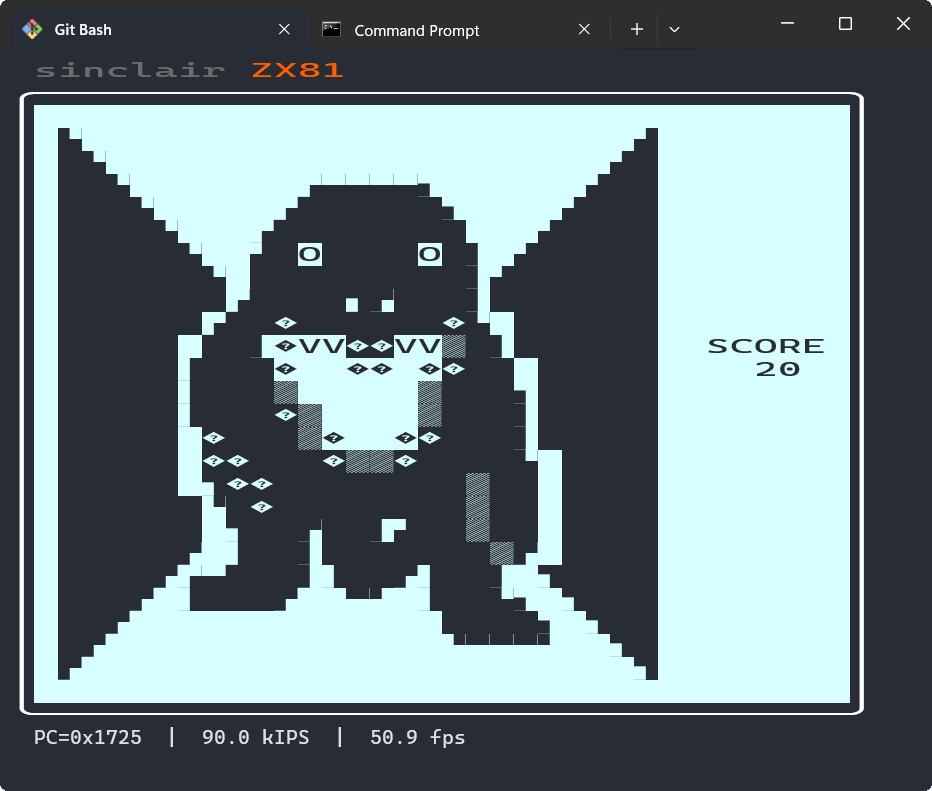An emulator for the Zilog Z80 8-bit CPU, to allow machine emulation of the Sinclair ZX81.
- Interrupt-related instructions (
DI,EI,IMand theIFF1,IFF2flags) and support for interrupts are not currently implemented. - I/O instructions (
IN,IND,INDR,INI,INIRandOUT,OUTD,OTDR,OUTI,OTIR) are not correctly implemented yet (particularly how they affect the condition bits / flags). - Instruction timing, T-states, machine-cycles are not currently implemented. Each instruction runs as fast as the JVM can execute it, which is completely unrelated to the timing on a real Z80.
- Although, ironically, most undocumented instructions had to be implemented to get the
zexdoctests to pass, the condition bits 3 and 5 (also known as flags X and Y) are not currently implemented. - The
zexdoctests don't test interrupt or I/O instructions, so there could be unexpected issues in these areas.
- The ZX81 ROM file should be placed at
src/main/resources/z80/zx81/zx81.rom, and any program files you would like to be able to load should be located insrc/main/resources/z80/zx81/with a lowercase filename and the file extension.p. To avoid issues with redistribution rights, these are not published to the GitHub repository. If I can get confirmation that these files are redistributable, this may change. - The emulator provides for
LOADof the.pfiles by typingLOAD "MYSAVEDFILE"in the emulator to load the resource/z80/zx81/mysavedfile.pfrom the classpath as a saved program. There is no correspondingSAVEcommand. - There can be issues with the keyboard. This affects games which don't scan the keyboard themselves nor wait for input using the standard routines (but rely solely on the interrupt-based screen display to update the system variables).
- There is no
SLOWorFASTmode. The machine likely thinks it is a ZX81 ROM running on ZX80 hardware because it will not see the NMI generator when it looks for it, but the display is updated about 50 times per second by "ghost hardware" that runs outside the machine emulation. - Timing is achieved using a
Thread.sleep(1)every few hundred instruction steps, to emulate about 95 instructions per millisecond (yep, that's how slow aSLOWmode ZX81 would be). It should be done using T-states and cycles rather than instructions - but in practice, it seems OK. Without this, most games are utterly unplayable. - The display is terminal-based, so it cannot support high-resolution graphics (even if the display were pixel-based, ZX81 pseudo-HRG requires CPU cycle-level timing to work, which the CPU emulation does not currently support).
- The Unicode "Symbols for Legacy Computing" block is not well-supported by fonts, so the half-grey graphic symbols (U+1FB8E and U+1FB8F and their inverted counterparts) may appear as the unknown glyph symbol (e.g. question mark in a diamond).
- I've only provided an implementation of the
TerminalSupportinterface for Windows, but it should be straightforward to add Linux or macOS implementations. Also, I've not worried about supporting old versions of Windows: you'll need a version of Windows (likely a recent build of Windows 10 or Windows 11) that supports UTF-8 console, and virtual terminal processing (including ANSI escapes for 256-color terminals, and ANSI virtual terminal input for cursor keys, etc.).
